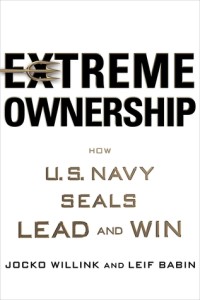 The theme from Leading Blog this week captivates me: personal responsibility. I’ve worked with numerous leadership teams who are struggling to accomplish objectives and goals. Helping them get to the root of the dysfunction requires five essential ingredients; vision, alignment, trust, collaboration and accountability. When working with a team, I always begin with the leader to assess “ownership” and work outwards from there.
The theme from Leading Blog this week captivates me: personal responsibility. I’ve worked with numerous leadership teams who are struggling to accomplish objectives and goals. Helping them get to the root of the dysfunction requires five essential ingredients; vision, alignment, trust, collaboration and accountability. When working with a team, I always begin with the leader to assess “ownership” and work outwards from there.
The notion of leadership as personal responsibility is the theme of the new book, Extreme Ownership by Navy SEAL officers Jocko Willink and Leif Babin. “Leaders must own everything in their world. There is no one else to blame.”
The authors highlight some of the critical problems that result from not taking responsibility. When it comes to what we want from our leaders throughout the organization, “it’s not what you preach, it’s what you tolerate“. They go on to say “When setting expectations, no matter what has been said or written, if substandard performance is accepted and no one is held accountable-if there are no consequences-the poor performance becomes the new standard.” This is why we see little change in leadership and organizational culture.
[notification type=”alert-info” close=”false” ]”It’s not what you preach, it’s what you tolerate”. – Jocko Willink and Lief Babin[/notification]
“Leadership isn’t one person leading a team. It’s a group of leaders working together, up and down the chain of command, to lead.” It’s critical that everyone is on the same page. Everyone must believe in the mission. If you don’t understand the mission, it is your responsibility to ask questions until you understand how and why the decisions being made are made.
The Clash of Ego’s
“Most of the disruptive issues that arise within any team can be attributed directly to a problem with ego.” What is interesting is when we don’t want to take any responsibility-when preserving our rightness is most important to us-we block others from seeing their responsibility. Instead of a learning experience we create a clash of egos. They write, “If you approached it as he did something wrong, and he needs to fix something, and he is at fault, it becomes a clash of egos and you two will be at odds. That’s human nature. But, if you put your own ego in check, meaning you take the blame, that will allow him to actually see the problem without his vision clouded by ego.”
By asserting our rightness we block others from being able to see their responsibility.
[notification type=”alert-success” close=”false”]
The four critical concepts that enable a team to perform at the highest level:
[list]
[li type=”glyphicon-arrow-right”]Cover and Move (to move as one)[/li]
[li type=”glyphicon-arrow-right”]Simple (keep plans and communications simple)[/li]
[li type=”glyphicon-arrow-right”]Prioritize and Execute (avoid target fixation on a single issue)[/li]
[li type=”glyphicon-arrow-right”]Decentralized Command (leaders at all levels must be empowered to make decisions)[/li]
[/list]
[/notification]
Finally they cover Sustaining Victory. Here are some thoughts from that section:
[well type=””]
One of the most important jobs of any leader is to support your own boss-you’re immediate leadership. Leaders in any chain of command will not always agree. But at the end of the day, once the debate on a particular course of action is over and the boss has made a decision-even if that decision is one you argued against-you must execute the plan as if it were your own.
The major factors to be aware of when leading up and down the chain of command are these:
- Take responsibility for leading everyone in your world, subordinates and superiors alike.
- If someone isn’t doing what you need them to do, look in the mirror first and determine what you can do to better enable this.
- Don’t ask your leader what you should do, tell them what you are going to do.
There is no 100 percent right solution. The picture is never complete. Leaders must be comfortable with this and be able to make decisions promptly, then be ready to adjust those decisions quickly based on evolving situations and new information. A leader must lead but also be ready to follow.”
[/well]
We invite you to post your comments. For more Step Up Leader resources, download my free audio here.

